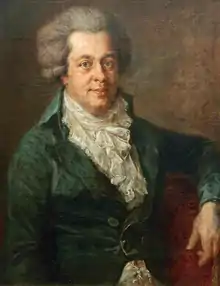Horn Concerto No. 1 (Mozart)
Wolfgang Amadeus Mozart's Horn Concerto No. 1 in D major, K. (412+514)/386b was written in 1791. The work is in two movements. Unusually, each movement received a distinct number in the first edition of the Köchel catalogue:
| Horn Concerto in D major | |
|---|---|
| No. 1 | |
| by W. A. Mozart | |
 The composer in 1790 | |
| Key | D major |
| Catalogue | K. (412+514)/386b |
| Genre | Concerto |
| Style | Classical period |
| Composed | 1791 |
| Movements | Two (Allegro, Rondo – Allegro) |
| Scoring |
|
The concerto is scored for solo horn, two oboes, two bassoons, and strings. This is one of two horn concertos of Mozart to include bassoons (the other is K. 447), but in this one he "treats them indifferently in the first movement."[2] It is the only one of Mozart's horn concertos to be in D major (the rest are in E-flat major) and the only one to have just two movements instead of the usual three (with the exception of the incompletely scored horn concerto, K. 370b+371).
Although numbered first, this was actually the last of the four to be completed. Compared to the other three horn concertos, it is shorter in duration (two movements rather than three) and is much simpler in regard to both range and technique, perhaps in a nod to the horn player (Mozart's great friend) Leutgeb's advanced age and (presumably) reduced capabilities at the time of composition. The second movement, K. 514, was shown by Alan Tyson to have been finished by Mozart's student Franz Xaver Süssmayr after Mozart's death.
Mozart's autograph score contains, arranged in strategic places throughout the sketch of the Rondo, a bizarre written narrative in Italian almost certainly directed to Leutgeb:[3]
For you, Mr. Donkey—Come on—quick—get on with it—like a good fellow—be brave—Are you finished yet?—for you—beast—oh what a dissonance—Oh!—Woe is me!!—Well done, poor chap—oh, pain in the balls!—Oh God, how fast!—you make me laugh—help—take a breather—go on, go on—that's a little better—still not finished?—you awful swine!—how charming you are!—dear one!—little donkey!—ha, ha, ha—take a breath!—But do play at least one note, you prick!—Aha! Bravo, bravo, hurrah!—You're going to bore me for the fourth time, and thank God it's the last—Oh finish now, I beg of you!—Confound it—also bravura?—Bravo!—oh, a sheep bleating—you're finished?—Thank heavens!—Enough, enough!
A comparison between Mozart's draft and Süssmayr's version reveals that Süssmayr used very little of Mozart's material: b.1–40 of Mozart's autograph corresponds almost exactly to b.1–44 of Süssmayr's version, and the two thereafter diverge with only a few passages in Süssmayr (b.59–62, 84–92, 109–116) bearing any close relationship to Mozart's material.[4] Süssmayr's rondo also makes use of a plainchant melody (the Lamentationes Ieremiae prophetae), and one explanation of this is that the melody was copied out by Mozart while he was composing the Requiem, which Süssmayr later mistook as material for the rondo.
Discography
Given its duration (no more than 10 minutes), the Concerto is typically grouped with Mozart's other 3 for the instrument. One famous recording is Dennis Brain's November 1953 recording of the four horn concertos on EMI with The Philharmonia Orchestra, conducted by Herbert von Karajan.
References
- Jean-Pierre Marty, The Tempo Indications of Mozart. New Haven & London: Yale University Press (1988): 43. "The very absence of sixteenths is also an incentive towards overly fast tempos, and this is why the finales of the Horn Concertos K. 386b, 417 and 447 are almost always performed faster than 88/264."
- Martha Kingdon Ward, "Mozart and the Bassoon" Music & Letters 30, 1 (1949): 9
- Maynard Solomon (1995) Mozart: A Life. Harper Collins: 357
- Benjamin Perl, The Doubtful Authenticity of Mozart’s Horn Concerto K 412
External links
- Concerto in D K. 412, first movement: Score and critical report (in German) in the Neue Mozart-Ausgabe
- Concerto in D K. 412, Süssmayr completion: Score and critical report (in German) in the Neue Mozart-Ausgabe
- Horn Concerto No. 1: Scores at the International Music Score Library Project